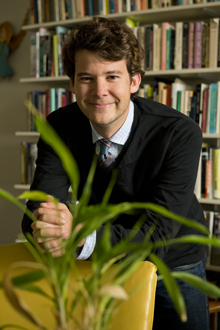A flowering of French literature in early Louisiana

Grad student Rien Fertel is studying French language print culture in early New Orleans and Louisiana. (Photo by Paula Burch-Celentano)
This vein of writing emerged after the Louisiana Purchase as the formerly French colony began filling with Americans.
“These white Creoles were men and some women living mostly in New Orleans,” says Fertel. “They were a close-knit group who wanted to create an exceptional literature within the United States, and by doing that declare: We will remain Frenchmen, we will continue to speak and write in French. At the same time, we will be American Frenchmen we will be Creoles.”
These literary Creoles wrote for the numerous French language newspapers of the city, contributing lively political commentary and literary, musical and theatrical reviews. Others published novels or scientific and scholarly works.
A few, like the Mercier brothers, Alfred and Armand, were prolific, publishing upward of 200 items. Others in the circle published only one or two titles such as plays or collections of poetry. One of the most noted of the group is Charles Gayarré, considered the founding father of Louisiana historical writing.
“Gayarré was among the earliest to claim a spot in the circle of white Creole writers,” says Fertel. “He was also the first to succumb to the encroachment of the English language. He gave up French in the 1840s and published in English in order to sell books.”
By the early 20th century, this circle had disappeared and the impulse that was its raison d'etre no longer energized Louisiana writers.
“The last French language New Orleans newspaper disappeared in the 1920s, and the most prominent French Creole society, the Athénée Louisianaise, folded a few decades later,” says Fertel.
